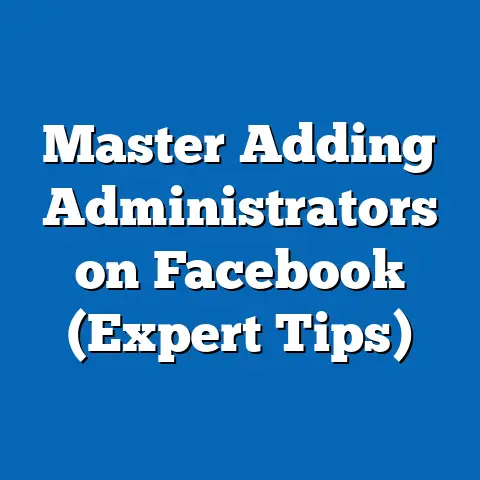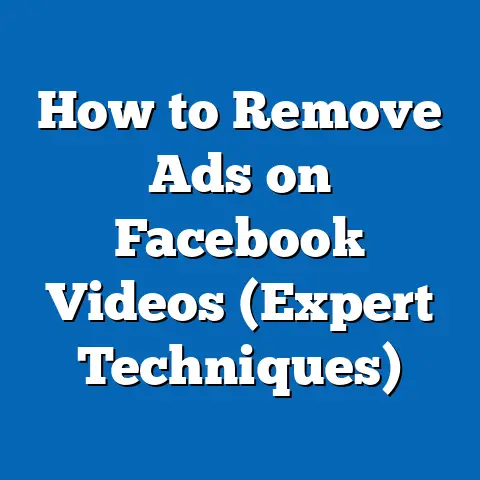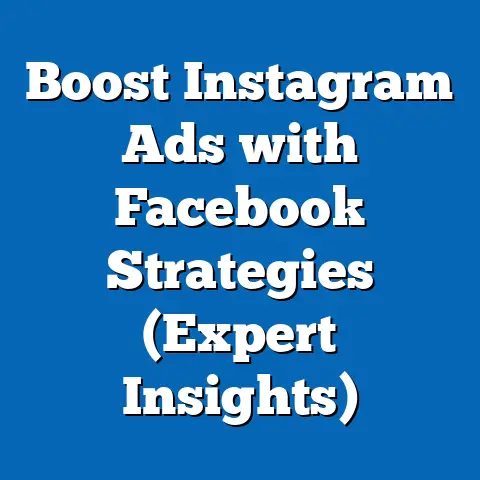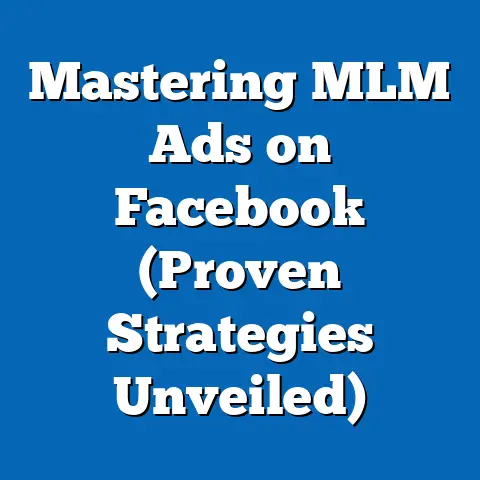Boost Sales with CRM-Facebook Ads Integration (Proven Strategy)
As a digital marketing expert, I’ve seen countless trends come and go. Some fade quickly, while others become foundational pillars of successful businesses. One strategy that has consistently proven its worth and continues to deliver exceptional results is the integration of Customer Relationship Management (CRM) systems with Facebook Ads.
Why is this integration so durable? Simply put, it’s because it leverages the power of data to create more targeted, personalized, and effective advertising campaigns. In today’s competitive market, generic, one-size-fits-all approaches simply don’t cut it. Businesses need to understand their customers intimately and deliver the right message at the right time. CRM-Facebook Ads integration allows them to do just that.
Sales are the lifeblood of any business. Without consistent revenue generation, even the most innovative and well-intentioned companies will struggle to survive. Technology plays a critical role in driving sales growth, and the synergy between CRM and Facebook Ads is a prime example of how to effectively leverage technology to achieve significant sales outcomes.
Let’s get started on the path to boosting your sales through the powerful combination of CRM and Facebook Ads!
Understanding CRM Systems
At its core, a Customer Relationship Management (CRM) system is a technology for managing all your company’s relationships and interactions with customers and potential customers. Think of it as the central nervous system of your customer-facing operations, collecting and organizing data from various touchpoints to provide a holistic view of each customer.
Definition and Purpose of CRM
The primary purpose of a CRM is to improve business relationships to grow your business. A CRM system helps companies stay connected to customers, streamline processes, and improve profitability. When people talk about CRM, they are usually referring to a CRM system, a tool that helps with contact management, sales management, productivity, and more.
Why is this important? Because understanding your customers is paramount to success. A CRM allows you to track customer interactions, analyze their behavior, identify their needs, and personalize your communication with them. This leads to stronger relationships, increased customer loyalty, and ultimately, higher sales.
My own experience working with various businesses has shown me that those who invest in a robust CRM system are significantly better equipped to understand their customer base and tailor their marketing efforts accordingly. I’ve seen companies struggling to manage leads and track customer interactions transform into highly efficient sales machines simply by implementing and utilizing a CRM effectively.
Types of CRM Software
The world of CRM software is vast and varied, with solutions catering to different business sizes, industries, and specific needs. Here are a few common types of CRM systems:
-
Operational CRM: This type focuses on automating sales, marketing, and service processes. It typically includes features like contact management, lead management, sales force automation, and marketing automation. Think of it as the workhorse of the CRM world, streamlining day-to-day operations and improving efficiency.
-
Analytical CRM: Analytical CRMs are designed to analyze customer data and provide insights into customer behavior, trends, and preferences. They often include features like data mining, predictive analytics, and reporting dashboards. This type is crucial for understanding your customers on a deeper level and making data-driven decisions.
-
Collaborative CRM: This type emphasizes collaboration and communication across different departments within a company. It aims to provide a unified view of the customer to all teams, ensuring that everyone is on the same page. Features often include shared contact databases, document management, and communication tools.
-
Cloud-Based CRM: These CRMs are hosted on the vendor’s servers and accessed via the internet. They offer flexibility, scalability, and lower upfront costs compared to on-premise solutions.
-
On-Premise CRM: These CRMs are installed on a company’s own servers and managed internally. They offer greater control over data and customization options but require more significant upfront investment and ongoing maintenance.
Operational CRM: This type focuses on automating sales, marketing, and service processes. It typically includes features like contact management, lead management, sales force automation, and marketing automation. Think of it as the workhorse of the CRM world, streamlining day-to-day operations and improving efficiency.
Analytical CRM: Analytical CRMs are designed to analyze customer data and provide insights into customer behavior, trends, and preferences. They often include features like data mining, predictive analytics, and reporting dashboards. This type is crucial for understanding your customers on a deeper level and making data-driven decisions.
Collaborative CRM: This type emphasizes collaboration and communication across different departments within a company. It aims to provide a unified view of the customer to all teams, ensuring that everyone is on the same page. Features often include shared contact databases, document management, and communication tools.
Cloud-Based CRM: These CRMs are hosted on the vendor’s servers and accessed via the internet. They offer flexibility, scalability, and lower upfront costs compared to on-premise solutions.
On-Premise CRM: These CRMs are installed on a company’s own servers and managed internally. They offer greater control over data and customization options but require more significant upfront investment and ongoing maintenance.
Choosing the right type of CRM depends on your specific business needs and resources. A small business might benefit from a simple, cloud-based CRM, while a large enterprise might require a more robust, on-premise solution.
Key Features of a Good CRM
Not all CRMs are created equal. A good CRM should offer a range of features designed to streamline your business processes, improve customer relationships, and drive sales growth. Here are some essential features to look for:
-
Contact Management: This is the foundation of any CRM. It allows you to store and organize all your customer information in one place, including contact details, communication history, and purchase records.
-
Lead Management: This feature helps you track and manage leads through the sales pipeline, from initial contact to conversion. It often includes lead scoring, lead nurturing, and automated follow-up.
-
Sales Tracking: This feature allows you to monitor your sales team’s performance, track deals in progress, and forecast future revenue. It provides valuable insights into your sales process and helps you identify areas for improvement.
-
Reporting and Analytics: A good CRM should offer robust reporting and analytics capabilities, allowing you to track key metrics, identify trends, and measure the effectiveness of your marketing and sales efforts.
-
Customer Support: This feature enables you to manage customer support requests, track issues, and provide timely and effective solutions. It helps you improve customer satisfaction and build long-term loyalty.
-
Marketing Automation: This feature automates repetitive marketing tasks, such as email marketing, social media posting, and lead generation. It helps you save time and resources while improving the effectiveness of your marketing campaigns.
-
Integration Capabilities: A CRM should integrate seamlessly with other business tools, such as email marketing platforms, accounting software, and, of course, Facebook Ads. This integration ensures that data flows smoothly between different systems, providing a unified view of the customer.
Contact Management: This is the foundation of any CRM. It allows you to store and organize all your customer information in one place, including contact details, communication history, and purchase records.
Lead Management: This feature helps you track and manage leads through the sales pipeline, from initial contact to conversion. It often includes lead scoring, lead nurturing, and automated follow-up.
Sales Tracking: This feature allows you to monitor your sales team’s performance, track deals in progress, and forecast future revenue. It provides valuable insights into your sales process and helps you identify areas for improvement.
Reporting and Analytics: A good CRM should offer robust reporting and analytics capabilities, allowing you to track key metrics, identify trends, and measure the effectiveness of your marketing and sales efforts.
Customer Support: This feature enables you to manage customer support requests, track issues, and provide timely and effective solutions. It helps you improve customer satisfaction and build long-term loyalty.
Marketing Automation: This feature automates repetitive marketing tasks, such as email marketing, social media posting, and lead generation. It helps you save time and resources while improving the effectiveness of your marketing campaigns.
Integration Capabilities: A CRM should integrate seamlessly with other business tools, such as email marketing platforms, accounting software, and, of course, Facebook Ads. This integration ensures that data flows smoothly between different systems, providing a unified view of the customer.
Takeaway: A CRM is more than just a database; it’s a powerful tool for understanding and managing your customer relationships. By choosing the right CRM and utilizing its key features effectively, you can significantly improve your sales performance and drive business growth.
The Power of Facebook Ads
With billions of active users, Facebook is a marketing powerhouse. Facebook Ads offer businesses an unparalleled opportunity to reach a massive audience with targeted and personalized advertising campaigns.
Introduction to Facebook Ads
Facebook Ads are paid messages that businesses create and display on the Facebook platform. These ads can take many forms, including:
-
Image Ads: Simple ads featuring a single image and accompanying text. They’re great for showcasing products or services visually.
-
Video Ads: Ads that use video to capture attention and convey a message. They’re ideal for storytelling, product demos, and brand building.
-
Carousel Ads: Ads that display multiple images or videos in a scrollable format. They’re perfect for showcasing a range of products or highlighting different features of a single product.
-
Collection Ads: Ads that feature a cover image or video followed by a selection of products. They’re designed to drive product discovery and sales.
-
Lead Ads: Ads that allow users to submit their contact information directly within the Facebook platform. They’re a great way to generate leads without sending users to an external landing page.
-
Instant Experience Ads: Full-screen, mobile-optimized ads that provide an immersive experience. They’re ideal for showcasing products, telling stories, and driving engagement.
Image Ads: Simple ads featuring a single image and accompanying text. They’re great for showcasing products or services visually.
Video Ads: Ads that use video to capture attention and convey a message. They’re ideal for storytelling, product demos, and brand building.
Carousel Ads: Ads that display multiple images or videos in a scrollable format. They’re perfect for showcasing a range of products or highlighting different features of a single product.
Collection Ads: Ads that feature a cover image or video followed by a selection of products. They’re designed to drive product discovery and sales.
Lead Ads: Ads that allow users to submit their contact information directly within the Facebook platform. They’re a great way to generate leads without sending users to an external landing page.
Instant Experience Ads: Full-screen, mobile-optimized ads that provide an immersive experience. They’re ideal for showcasing products, telling stories, and driving engagement.
The beauty of Facebook Ads lies in their versatility. You can choose the ad format that best suits your message and target audience.
Targeting Capabilities
One of the most significant advantages of Facebook Ads is its advanced targeting capabilities. Facebook collects a wealth of data on its users, allowing advertisers to reach specific audiences based on:
-
Demographics: Age, gender, location, education, job title, and more.
-
Interests: Hobbies, activities, pages they like, and topics they follow.
-
Behaviors: Purchase history, online activity, device usage, and more.
-
Custom Audiences: Lists of existing customers or website visitors that you upload to Facebook.
-
Lookalike Audiences: Audiences that are similar to your existing customers, allowing you to expand your reach to new potential customers.
Demographics: Age, gender, location, education, job title, and more.
Interests: Hobbies, activities, pages they like, and topics they follow.
Behaviors: Purchase history, online activity, device usage, and more.
Custom Audiences: Lists of existing customers or website visitors that you upload to Facebook.
Lookalike Audiences: Audiences that are similar to your existing customers, allowing you to expand your reach to new potential customers.
This granular targeting allows you to deliver your message to the people who are most likely to be interested in your products or services. I’ve personally seen campaigns achieve incredible results simply by leveraging Facebook’s targeting capabilities to reach the right audience.
For example, I worked with a local bakery that was struggling to attract new customers. By targeting Facebook users who were interested in baking, cooking, and local food, we were able to significantly increase their foot traffic and sales.
Benefits of Advertising on Facebook
Advertising on Facebook offers a range of benefits, including:
-
Wide Reach: With billions of active users, Facebook provides access to a massive audience.
-
Cost-Effectiveness: Facebook Ads can be very cost-effective, especially when compared to traditional advertising channels. You can set your budget and bid for ad placements, ensuring that you only pay for the results you want.
-
Targeted Advertising: Facebook’s advanced targeting capabilities allow you to reach specific audiences with relevant messages.
-
Measurable Results: Facebook Ads Manager provides detailed reporting and analytics, allowing you to track your campaign performance and measure your return on investment.
-
Brand Building: Facebook Ads can help you increase brand awareness and build relationships with your target audience.
-
Lead Generation: Facebook Lead Ads make it easy to generate leads without sending users to an external landing page.
Wide Reach: With billions of active users, Facebook provides access to a massive audience.
Cost-Effectiveness: Facebook Ads can be very cost-effective, especially when compared to traditional advertising channels. You can set your budget and bid for ad placements, ensuring that you only pay for the results you want.
Targeted Advertising: Facebook’s advanced targeting capabilities allow you to reach specific audiences with relevant messages.
Measurable Results: Facebook Ads Manager provides detailed reporting and analytics, allowing you to track your campaign performance and measure your return on investment.
Brand Building: Facebook Ads can help you increase brand awareness and build relationships with your target audience.
Lead Generation: Facebook Lead Ads make it easy to generate leads without sending users to an external landing page.
Takeaway: Facebook Ads are a powerful tool for reaching a massive audience with targeted and personalized advertising campaigns. By leveraging Facebook’s advanced targeting capabilities and utilizing the right ad formats, you can achieve significant results and drive business growth.
The Importance of Integration
Now that we’ve covered CRM systems and Facebook Ads individually, let’s explore the power of integrating the two. This integration allows you to leverage the wealth of data stored in your CRM to create more effective and personalized Facebook Ads campaigns.
What is CRM-Facebook Ads Integration?
CRM-Facebook Ads integration is the process of connecting your CRM system to your Facebook Ads account. This connection allows data to flow seamlessly between the two platforms, enabling you to use your CRM data to target, personalize, and optimize your Facebook Ads campaigns.
The technical aspects of integration typically involve using Facebook’s Marketing API or a third-party integration tool. These tools allow you to connect your CRM to Facebook Ads and synchronize data between the two platforms.
Benefits of Integration
The benefits of integrating CRM with Facebook Ads are numerous and can have a significant impact on your marketing performance. Here are a few key advantages:
-
Improved Customer Insights: Integration provides a more complete view of your customers by combining data from your CRM with data from Facebook. This allows you to understand your customers’ behavior, preferences, and needs on a deeper level.
-
Streamlined Advertising Efforts: Integration automates many of the manual tasks involved in creating and managing Facebook Ads campaigns. This saves you time and resources, allowing you to focus on strategy and optimization.
-
Enhanced Customer Engagement: Integration allows you to personalize your Facebook Ads campaigns based on data from your CRM. This leads to more relevant and engaging ads, which can improve click-through rates, conversion rates, and customer loyalty.
-
More Effective Targeting: Integration allows you to use your CRM data to create custom audiences and lookalike audiences on Facebook. This ensures that your ads are reaching the people who are most likely to be interested in your products or services.
-
Improved Lead Quality: By targeting your Facebook Ads based on CRM data, you can attract higher-quality leads who are more likely to convert into customers.
-
Better ROI: Integration can improve your return on investment by optimizing your Facebook Ads campaigns based on data from your CRM. This ensures that you’re spending your advertising budget effectively and achieving the results you want.
Improved Customer Insights: Integration provides a more complete view of your customers by combining data from your CRM with data from Facebook. This allows you to understand your customers’ behavior, preferences, and needs on a deeper level.
Streamlined Advertising Efforts: Integration automates many of the manual tasks involved in creating and managing Facebook Ads campaigns. This saves you time and resources, allowing you to focus on strategy and optimization.
Enhanced Customer Engagement: Integration allows you to personalize your Facebook Ads campaigns based on data from your CRM. This leads to more relevant and engaging ads, which can improve click-through rates, conversion rates, and customer loyalty.
More Effective Targeting: Integration allows you to use your CRM data to create custom audiences and lookalike audiences on Facebook. This ensures that your ads are reaching the people who are most likely to be interested in your products or services.
Improved Lead Quality: By targeting your Facebook Ads based on CRM data, you can attract higher-quality leads who are more likely to convert into customers.
Better ROI: Integration can improve your return on investment by optimizing your Facebook Ads campaigns based on data from your CRM. This ensures that you’re spending your advertising budget effectively and achieving the results you want.
Real-World Examples
To illustrate the power of CRM-Facebook Ads integration, let’s look at a few real-world examples:
-
Example 1: E-commerce Company
An e-commerce company integrated its CRM with Facebook Ads to create custom audiences based on purchase history. They then targeted these audiences with personalized product recommendations and promotions. As a result, they saw a 20% increase in sales and a 15% increase in customer retention.
-
Example 2: SaaS Company
A SaaS company integrated its CRM with Facebook Ads to create lookalike audiences based on its existing customer base. They then targeted these audiences with ads promoting their software. This resulted in a 30% increase in leads and a 25% decrease in cost per acquisition.
-
Example 3: Local Restaurant
A local restaurant integrated its CRM with Facebook Ads to create custom audiences based on email subscribers. They then targeted these audiences with ads promoting special offers and events. This resulted in a 15% increase in foot traffic and a 10% increase in sales.
Example 1: E-commerce Company
An e-commerce company integrated its CRM with Facebook Ads to create custom audiences based on purchase history. They then targeted these audiences with personalized product recommendations and promotions. As a result, they saw a 20% increase in sales and a 15% increase in customer retention.
Example 2: SaaS Company
A SaaS company integrated its CRM with Facebook Ads to create lookalike audiences based on its existing customer base. They then targeted these audiences with ads promoting their software. This resulted in a 30% increase in leads and a 25% decrease in cost per acquisition.
Example 3: Local Restaurant
A local restaurant integrated its CRM with Facebook Ads to create custom audiences based on email subscribers. They then targeted these audiences with ads promoting special offers and events. This resulted in a 15% increase in foot traffic and a 10% increase in sales.
These examples demonstrate the potential of CRM-Facebook Ads integration to drive significant results for businesses of all sizes and industries.
Takeaway: Integrating your CRM with Facebook Ads allows you to leverage your customer data to create more targeted, personalized, and effective advertising campaigns. This can lead to improved customer insights, streamlined advertising efforts, enhanced customer engagement, and a better return on investment.
Proven Strategies for Effective Integration
Now that you understand the benefits of CRM-Facebook Ads integration, let’s dive into the proven strategies for implementing and optimizing your own integrated campaigns.
Step-by-Step Guide to Integration
Integrating your CRM system with Facebook Ads may seem daunting, but it can be broken down into a series of manageable steps:
-
Choose an Integration Method: Decide whether you want to use Facebook’s Marketing API, a third-party integration tool, or a custom solution. The best option depends on your technical resources and the complexity of your integration needs.
-
Connect Your CRM to Facebook Ads: Follow the instructions provided by your chosen integration method to connect your CRM to your Facebook Ads account. This typically involves granting access to your CRM data and configuring the data synchronization settings.
-
Define Your Target Audiences: Determine which customer segments you want to target with your Facebook Ads campaigns. This could be based on purchase history, demographics, interests, or any other data stored in your CRM.
-
Create Custom Audiences: Use your CRM data to create custom audiences on Facebook. You can upload lists of customers or website visitors, or you can use your CRM data to create dynamic audiences that update automatically.
-
Develop Personalized Ad Creative: Create ad creative that is relevant and engaging to your target audiences. Use your CRM data to personalize your ads with customer names, product recommendations, or other relevant information.
-
Set Your Budget and Bidding Strategy: Determine how much you want to spend on your Facebook Ads campaigns and choose a bidding strategy that aligns with your goals.
-
Monitor and Optimize Your Campaigns: Track your campaign performance and make adjustments as needed. Use the data from Facebook Ads Manager and your CRM to identify areas for improvement and optimize your campaigns for maximum results.
Choose an Integration Method: Decide whether you want to use Facebook’s Marketing API, a third-party integration tool, or a custom solution. The best option depends on your technical resources and the complexity of your integration needs.
Connect Your CRM to Facebook Ads: Follow the instructions provided by your chosen integration method to connect your CRM to your Facebook Ads account. This typically involves granting access to your CRM data and configuring the data synchronization settings.
Define Your Target Audiences: Determine which customer segments you want to target with your Facebook Ads campaigns. This could be based on purchase history, demographics, interests, or any other data stored in your CRM.
Create Custom Audiences: Use your CRM data to create custom audiences on Facebook. You can upload lists of customers or website visitors, or you can use your CRM data to create dynamic audiences that update automatically.
Develop Personalized Ad Creative: Create ad creative that is relevant and engaging to your target audiences. Use your CRM data to personalize your ads with customer names, product recommendations, or other relevant information.
Set Your Budget and Bidding Strategy: Determine how much you want to spend on your Facebook Ads campaigns and choose a bidding strategy that aligns with your goals.
Monitor and Optimize Your Campaigns: Track your campaign performance and make adjustments as needed. Use the data from Facebook Ads Manager and your CRM to identify areas for improvement and optimize your campaigns for maximum results.
Utilizing Customer Data
The key to successful CRM-Facebook Ads integration is leveraging your customer data effectively. Here are a few ways to utilize your CRM data to create targeted and personalized Facebook Ads:
-
Target Customers Based on Purchase History: Target customers who have previously purchased specific products or services with ads promoting complementary products or special offers.
-
Target Customers Based on Demographics: Target customers based on their age, gender, location, or other demographic information.
-
Target Customers Based on Interests: Target customers based on their interests and hobbies.
-
Personalize Ads with Customer Names: Use customer names in your ad copy to create a more personal and engaging experience.
-
Recommend Products Based on Past Purchases: Recommend products that are similar to those that customers have previously purchased.
-
Offer Exclusive Discounts to Loyal Customers: Reward loyal customers with exclusive discounts and promotions.
Target Customers Based on Purchase History: Target customers who have previously purchased specific products or services with ads promoting complementary products or special offers.
Target Customers Based on Demographics: Target customers based on their age, gender, location, or other demographic information.
Target Customers Based on Interests: Target customers based on their interests and hobbies.
Personalize Ads with Customer Names: Use customer names in your ad copy to create a more personal and engaging experience.
Recommend Products Based on Past Purchases: Recommend products that are similar to those that customers have previously purchased.
Offer Exclusive Discounts to Loyal Customers: Reward loyal customers with exclusive discounts and promotions.
Measuring Success
To ensure that your CRM-Facebook Ads integration is delivering the results you want, it’s essential to track key metrics and KPIs. Here are a few metrics to consider:
-
Return on Ad Spend (ROAS): This metric measures the revenue generated for every dollar spent on Facebook Ads.
-
Conversion Rate: This metric measures the percentage of users who take a desired action, such as making a purchase or submitting a lead form.
-
Customer Acquisition Cost (CAC): This metric measures the cost of acquiring a new customer through Facebook Ads.
-
Customer Lifetime Value (CLTV): This metric measures the total revenue a customer is expected to generate over their relationship with your company.
-
Customer Retention Rate: This metric measures the percentage of customers who remain customers over a given period.
Return on Ad Spend (ROAS): This metric measures the revenue generated for every dollar spent on Facebook Ads.
Conversion Rate: This metric measures the percentage of users who take a desired action, such as making a purchase or submitting a lead form.
Customer Acquisition Cost (CAC): This metric measures the cost of acquiring a new customer through Facebook Ads.
Customer Lifetime Value (CLTV): This metric measures the total revenue a customer is expected to generate over their relationship with your company.
Customer Retention Rate: This metric measures the percentage of customers who remain customers over a given period.
By tracking these metrics, you can identify areas for improvement and optimize your campaigns for maximum ROI.
Common Mistakes to Avoid
While CRM-Facebook Ads integration can be incredibly powerful, it’s essential to avoid common pitfalls that can derail your efforts. Here are a few mistakes to avoid:
-
Not Having a Clear Strategy: Before you begin integrating your CRM with Facebook Ads, it’s essential to have a clear strategy in place. Define your goals, identify your target audiences, and develop a plan for how you will utilize your customer data.
-
Not Properly Segmenting Your Data: Segmenting your data is crucial for creating targeted and personalized Facebook Ads campaigns. Make sure you have a clear understanding of your customer segments and how you want to target them.
-
Not Monitoring Your Campaigns: It’s essential to monitor your campaigns regularly and make adjustments as needed. Track key metrics and KPIs and use the data to optimize your campaigns for maximum ROI.
-
Ignoring Data Privacy: Be sure to comply with all data privacy regulations, such as GDPR and CCPA. Obtain consent from your customers before using their data for advertising purposes.
Not Having a Clear Strategy: Before you begin integrating your CRM with Facebook Ads, it’s essential to have a clear strategy in place. Define your goals, identify your target audiences, and develop a plan for how you will utilize your customer data.
Not Properly Segmenting Your Data: Segmenting your data is crucial for creating targeted and personalized Facebook Ads campaigns. Make sure you have a clear understanding of your customer segments and how you want to target them.
Not Monitoring Your Campaigns: It’s essential to monitor your campaigns regularly and make adjustments as needed. Track key metrics and KPIs and use the data to optimize your campaigns for maximum ROI.
Ignoring Data Privacy: Be sure to comply with all data privacy regulations, such as GDPR and CCPA. Obtain consent from your customers before using their data for advertising purposes.
Takeaway: By following these proven strategies and avoiding common mistakes, you can successfully integrate your CRM with Facebook Ads and achieve significant results. Remember to have a clear strategy, segment your data properly, monitor your campaigns regularly, and comply with data privacy regulations.
Advanced Techniques for Optimization
Once you’ve implemented the basic strategies for CRM-Facebook Ads integration, you can take your campaigns to the next level with advanced optimization techniques.
A/B Testing
A/B testing, also known as split testing, is the process of comparing two versions of an ad to see which one performs better. This is a powerful technique for optimizing your Facebook Ads campaigns and improving your ROI.
CRM data can inform your A/B testing strategies by providing insights into customer preferences and behavior. For example, you can use your CRM data to identify which ad copy resonates best with different customer segments or which product recommendations are most likely to drive sales.
Here are a few examples of A/B tests you can run using CRM data:
-
Test Different Ad Copy: Test different ad copy variations to see which one generates the most clicks and conversions. Use your CRM data to personalize the ad copy with customer names, product recommendations, or other relevant information.
-
Test Different Images or Videos: Test different images or videos to see which one captures the most attention and drives the most engagement. Use your CRM data to select images or videos that are relevant to your target audience.
-
Test Different Call-to-Actions: Test different call-to-actions to see which one generates the most conversions. Use your CRM data to personalize the call-to-action with specific offers or promotions.
Test Different Ad Copy: Test different ad copy variations to see which one generates the most clicks and conversions. Use your CRM data to personalize the ad copy with customer names, product recommendations, or other relevant information.
Test Different Images or Videos: Test different images or videos to see which one captures the most attention and drives the most engagement. Use your CRM data to select images or videos that are relevant to your target audience.
Test Different Call-to-Actions: Test different call-to-actions to see which one generates the most conversions. Use your CRM data to personalize the call-to-action with specific offers or promotions.
Retargeting Strategies
Retargeting is the process of showing ads to people who have previously interacted with your business. This is a highly effective technique for re-engaging previous customers and leads and driving conversions.
CRM data can be used to create effective retargeting campaigns on Facebook. For example, you can use your CRM data to target users who have visited your website, added items to their cart, or made a purchase in the past.
Here are a few examples of retargeting strategies you can use with CRM data:
-
Target Website Visitors: Target users who have visited your website but haven’t made a purchase with ads promoting special offers or discounts.
-
Target Abandoned Cart Users: Target users who have added items to their cart but haven’t completed the checkout process with ads reminding them of their cart and offering free shipping or other incentives.
-
Target Past Purchasers: Target users who have previously made a purchase with ads promoting complementary products or special offers.
Target Website Visitors: Target users who have visited your website but haven’t made a purchase with ads promoting special offers or discounts.
Target Abandoned Cart Users: Target users who have added items to their cart but haven’t completed the checkout process with ads reminding them of their cart and offering free shipping or other incentives.
Target Past Purchasers: Target users who have previously made a purchase with ads promoting complementary products or special offers.
Creating Lookalike Audiences
Lookalike audiences are audiences that are similar to your existing customers. This is a powerful technique for expanding your reach to new potential customers who are likely to be interested in your products or services.
CRM data can be used to create lookalike audiences on Facebook. You can upload your customer list to Facebook and create a lookalike audience based on the characteristics of your existing customers.
Takeaway: By utilizing advanced techniques such as A/B testing, retargeting strategies, and creating lookalike audiences, you can optimize your CRM-Facebook Ads integration and achieve even greater results. Remember to continuously test and refine your campaigns based on data and insights from your CRM and Facebook Ads Manager.
To recap, integrating your CRM with Facebook Ads allows you to leverage your customer data to create more targeted, personalized, and effective advertising campaigns. This can lead to improved customer insights, streamlined advertising efforts, enhanced customer engagement, and a better return on investment.
The durability of this strategy lies in its ability to adapt to changing customer behaviors and market dynamics. By continuously leveraging data and insights from your CRM, you can ensure that your Facebook Ads campaigns remain relevant and effective over time.
Now, I encourage you to assess your current CRM and advertising strategies. Consider the potential benefits of integration and take actionable steps towards implementing these proven strategies to enhance your sales performance. Don’t be afraid to experiment with different techniques and continuously optimize your campaigns based on data and insights.
The future of advertising is data-driven and personalized. By embracing CRM-Facebook Ads integration, you can position your business for success in the ever-evolving digital landscape.






